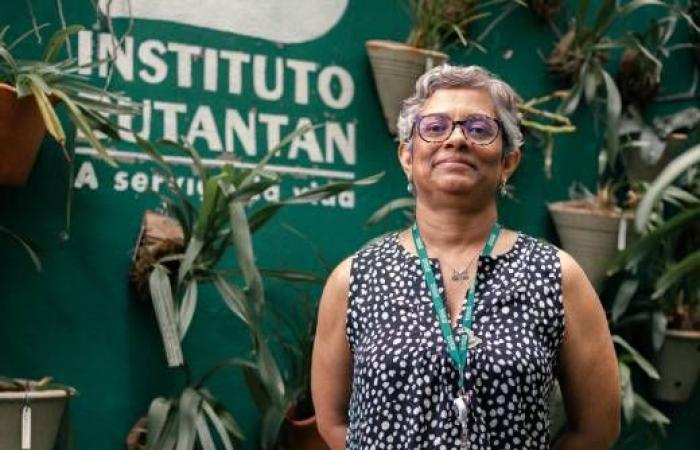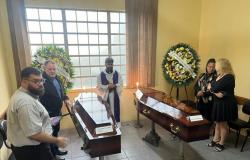
NIAID researcher and scientific reviewer Anuja Mathew, who has 25 years of experience in studying the immune response to dengue, was in Butantan between January and March, on a scientific exchange organized by the United States Embassy. In an interview with Portal do Butantan, the scientist spoke about the complexity of the dengue virus and the detailed work involved in developing the vaccine.
“It’s as if you were producing four vaccines. NIAID researchers had to identify which genotypes of each type were safe, capable of replicating well and inducing an immune response. It’s not a simple task”, says the expert.
Anuja Mathew is a scientific reviewer at NIAID and was at Butantan on a scientific exchange
In 2009, the NIH transferred the patents for the strains to Butantan, an agency linked to the State Department of Health of São Paulo, so that the Institute could develop the vaccine in Brazil. From then on, it took another four years of work and more than 200 experiments to obtain the final version that would be used in trials on human beings – a challenge faced by the team of researcher Neuza Frazatti Gallina, from Butantan.
“The four viruses must be treated separately: in the concentration, purification and lyophilization processes of each monovalent, the viral load can decrease. So you need to calculate and predict these losses for each virus, to arrive at a safe and effective tetravalent candidate”, explains Anuja. “Butantan was able to overcome all these obstacles and formulate the vaccine to conduct clinical studies.”
Anuja also highlights the reach of the clinical trials network built by Butantan, which included 16 research centersin all regions of Brazil, where the vaccine study has been carried out since 2016. In two years of monitoring, the vaccine demonstrated 79.6% efficacy, according to published study in January at The New England Journal of Medicine.

The researcher visited the factory where the Butantan dengue vaccine is being produced
Vaccine differences
According to Anuja Mathew, the vaccine has a series of differences. A Single dose accelerates the full protection of the population, who do not need to return for a new dose, while the low cost it makes it easier for the vaccine to reach those who need it most – residents of countries in Latin America, Africa and Asia, where the disease is endemic.
Another advantage is that the immunogenicity is equivalent between dengue serotypes. Although it is still necessary to evaluate the effectiveness of the vaccine against DENV3 and DENV4, which did not circulate in Brazil during phase 3 of the clinical trial, previous stages of the research indicated that the vaccine induces neutralizing antibodies against the four viruses.
Anuja also highlights that the vaccine is structured by the four attenuated serotypes, that is, it contains the four original sequels, with structural and non-structural proteins. The other available immunizers only have the structural proteins of the dengue virus, and use the yellow fever virus or DENV-2 as a base.
“Dengue viruses have structural and non-structural proteins. Non-structural proteins are detected by T lymphocytes, inducing an important cellular response”, explains Anuja, who was one of the pioneers in showing that non-structural proteins are dominant targets of T cells, in study published in 1998 at the Journal of Virology. T cells act to eliminate cells infected by the virus.
The scientist completed her doctorate at the University of Massachusetts Medical School, in the United States, where she studied the immune response of children to the dengue virus using blood samples collected in Thailand. At the same university, she worked in the Center for Infectious Diseases and Vaccine Research and in the Division of Infectious Diseases and Immunology, continuing research in the area.
For Anuja, the production of the vaccine by a public institution in Brazil is advantageous not only for the country itself, but for all of Latin America, which has faced dengue epidemics. The incidence in the region grew from 1.5 million cases accumulated in 1980 to 16.2 million between 2010 and 2019, according to Pan American Health Organization (OPAS). The licensing of Butantan’s vaccine technology to the multinational MSD will also help to take the product to other regions of the world.
“I grew up in India and saw a level of poverty that was very difficult to combat. In order to truly combat neglected tropical diseases, such as dengue fever, long-term investment in vaccines, vector control and public health educationa”, he highlights. “Science is long and difficult, and there are very few rewards – we cannot expect easy results. Collaboration between scientists around the world is essential.”
-af338931d5d46a5c.jpg)
Anuja explained the role of the NIH and discussed the possibility of future collaborations between the institutions
Fostering new partnerships
Anuja Mathew spent two months as a visiting consultant at Butantan to learn about the factory and the dengue vaccine production process, in addition to presenting the NIH’s work to the Institute’s teams and discussing best research practices and funding possibilities. Her goal was strengthen the relationship between Butantan and NIH and establish new partnerships among researchers at the institutions. The visit was part of the United States Embassies Scientific Exchange Program, which promotes the exchange of knowledge between North American and foreign scientists.
“Butantan has all the facilities and expertise necessary for large-scale vaccine production and research development. The fact of manufacturing the influenza vaccine for all of Brazil, for example, is a great achievement. It is certainly an institution with which the NIH would like to continue seeking collaborations”, says the researcher.
The North American institution has supported Brazilian research since the 1980s, financing projects in the areas of allergy, immunology, transplants, fungal diseases, HIV, influenza, malaria, tuberculosis, among others. To encourage these collaborations, the US-Brazil Biomedical Research Collaborative Program was created in 2014 between the Ministry of Health, the Ministry of Science, Technology and Innovation and the NIH.
Part of the US government’s Department of Health and Human Services, the NIH is made up of 27 public institutions with different research and funding focuses, and is considered one of the largest funders of biomedical research in the world.
emergency state
At the beginning of March, the government of São Paulo declared a public health emergency for dengue, at which point the state reached 300 confirmed cases of the disease per 100,000 inhabitants. In Brazil, in 2024, the number of probable cases will already exceed 1.5 million, with 450 deaths, according to the Arbovirus Monitoring Panel of the Ministry of Health.
If approved by the National Health Surveillance Agency (Anvisa), the Butantan vaccine may be made available in the future in the Unified Health System (SUS). The single-dose schedule facilitates logistics and vaccination adherence – important factors in an epidemic context.
Efficacy data from phase 3 of the clinical trial, referring to the first two years of follow-up, must be sent to Anvisa in the second half of 2024, which will begin the process of requesting definitive registration.
Reporting: Aline Tavares
Photos: José Felipe Batista/Comunicação Butantan
Tags: Butantan NIH partnership public institutions Brazil USA resulted effective affordable dengue vaccine
--




